Mastering Classic French Onion Soup: An Easy Homemade Recipe for Restaurant-Quality Flavor
Discover the secrets to crafting a truly exceptional French onion soup right in your own kitchen with this comprehensive and easy-to-follow recipe. This beloved classic transforms humble onions into a deeply flavorful, sweet, and savory broth through the magic of slow caramelization. Each spoonful delivers a symphony of rich flavors, perfectly complemented by golden, bubbly, cheese-topped croutons. While often perceived as complex, our recipe demystifies the process, proving that this indulgent and comforting dish is surprisingly accessible with just a few simple ingredients and a touch of patience. We’ll guide you through every step, from selecting the perfect onions to achieving that exquisite caramelized depth, and even offer creative customizations to suit various dietary needs or preferences. Prepare to impress your family and friends with a soup that tastes like it came straight from a Parisian bistro.
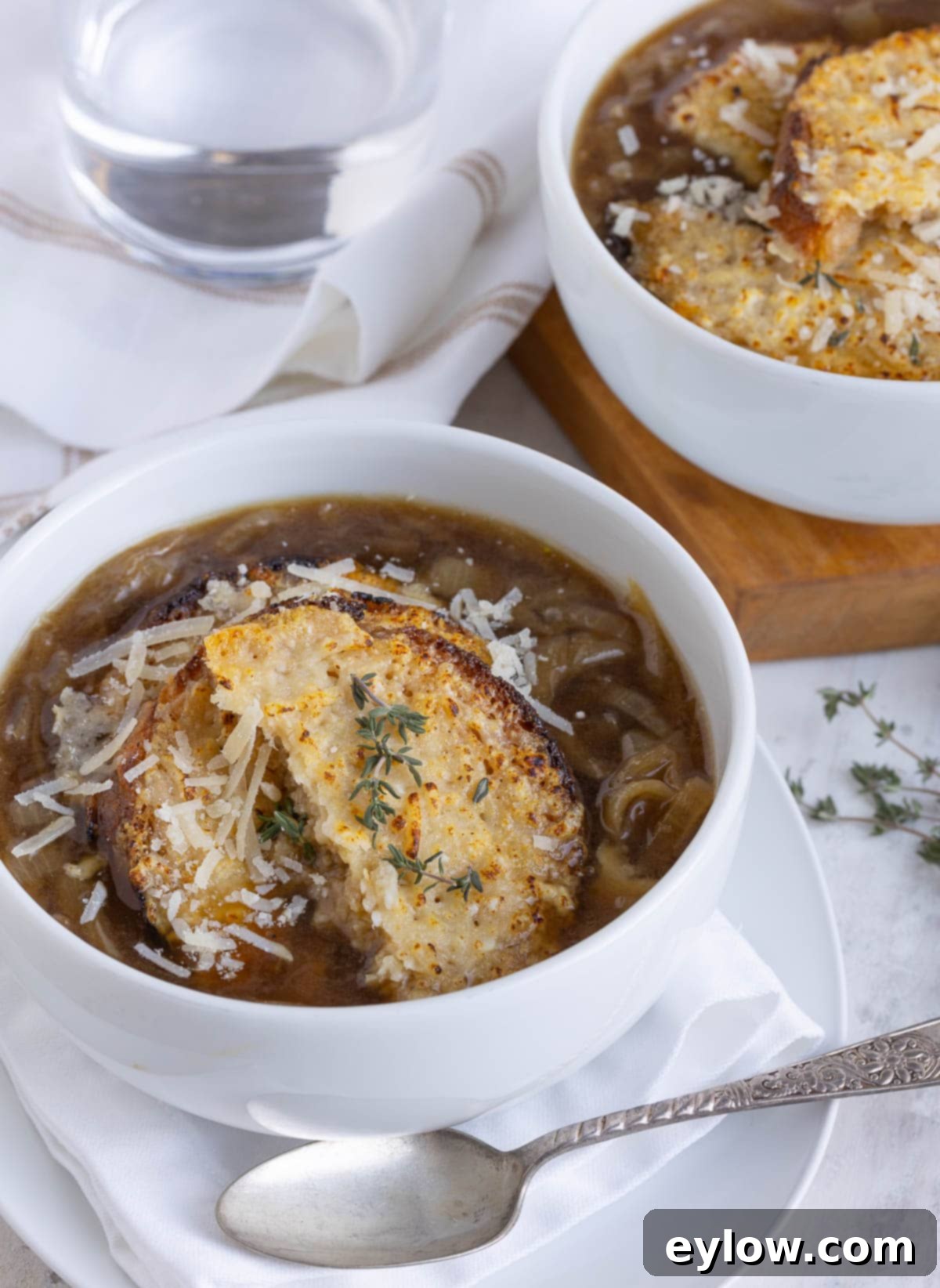
That first spoonful of authentic French onion soup is an experience unto itself. The depth of flavor, the comforting warmth, and the luxurious texture of perfectly caramelized onions are what make this soup a timeless favorite. Achieving this level of deliciousness at home requires a little dedication to slowly caramelizing the onions, a process that coaxed out their natural sugars and transforms their pungent bite into meltingly sweet and savory goodness. This foundational step is the heart of the soup, creating a rich base that infuses the entire broth with an unparalleled depth. When combined with a robust broth and crowned with perfectly crispy, cheesy croutons, it’s truly amazing how such simple ingredients can yield such an incredibly satisfying and gourmet taste. This recipe provides all the guidance you need to create this culinary masterpiece with confidence.
Why This Easy French Onion Soup Recipe Will Become Your Go-To
This French onion soup recipe isn’t just about making soup; it’s about creating a memorable dining experience with ease. Here’s why you’ll absolutely adore it:
- Simple, Rich Flavors: The beauty of this soup lies in its simplicity. By focusing on quality ingredients and the transformative power of slow cooking, we achieve incredibly rich, savory, and sweet flavors that are both comforting and sophisticated. The magic happens as onions slowly caramelize, developing a complex umami depth that becomes the soul of the soup.
- Versatile for Dietary Needs: We understand that everyone has different dietary requirements. This recipe offers easy substitutions for vegetarian and vegan diners, ensuring that no one misses out on this incredible dish. From plant-based butter to vegetable broth, adapting this recipe is straightforward and delicious.
- Customizable Onions and Cheese: Whether you prefer the classic yellow onion sweetness or the milder notes of a Spanish onion, this recipe guides you on selecting the best variety for your taste. Similarly, while Gruyère is traditional, we provide a range of cheese options that melt beautifully and add their own unique character, allowing you to personalize every bowl.
- Excellent for Meal Prep and Freezing: Planning ahead is a breeze with this French onion soup. The soup base can be made up to 3 days in advance, allowing flavors to deepen even further. It also freezes exceptionally well, making it perfect for having a comforting meal ready whenever cravings strike. Just prepare the croutons fresh for the best texture!
If you’re already a fan of French onion soup’s incredible flavors, you might also love exploring other dishes inspired by its profile. For a hearty and equally satisfying meal, be sure to try my French onion soup chicken skillet recipe!
Essential Ingredients for Your Homemade French Onion Soup
Crafting the perfect French onion soup starts with understanding the role of each ingredient. Here’s a detailed look at what you’ll need and why:
- Onions: The undisputed star of the show! For the best flavor, use yellow, brown, or sweet onions. Yellow onions are traditional and offer a robust flavor that sweetens beautifully when caramelized. Sweet varieties like Vidalia also work wonderfully, providing a naturally higher sugar content for deeper caramelization. Proper slicing is key here to ensure even cooking.
- Fat: A combination of butter and olive oil is ideal for cooking the onions. The butter contributes rich flavor, while the olive oil helps prevent burning and allows for a higher cooking temperature. For dairy-free versions, plant-based butter or simply using all olive oil works perfectly without compromising the end result.
- Broth: The quality of your broth significantly impacts the final taste of your soup. Beef broth is the classic choice, lending a deep, savory foundation. However, excellent substitutions exist for those who prefer lighter or vegetarian options (see below). Always opt for good quality store-bought or homemade broth; steer clear of bouillon cubes or pastes, which often contain excessive sodium and artificial flavors. Choose low or no-sodium broth to maintain control over the saltiness. Don’t limit yourself to cans or boxes; check the freezer section of your grocery store for premium broths, as these often offer superior flavor and freshness.
- Garlic: While not a primary flavor, garlic adds an aromatic depth that beautifully complements the sweet caramelized onions. Using fresh garlic, finely chopped or grated with a microplane zester, will yield the best, most vibrant flavor compared to pre-minced or powdered alternatives.
- Herbs: Fresh thyme and a bay leaf are essential for infusing the broth with classic French aromatics. Thyme provides an earthy, subtly floral note, while the bay leaf contributes a complex, savory undertone. Parsley is an optional garnish, adding a touch of freshness and color before serving.
- Deglazing Liquid: This step is crucial for unlocking rich flavors stuck to the bottom of your pot. A dry white wine (like Sauvignon Blanc or Pinot Grigio), dry sherry, or even a dry red wine can be used. The alcohol helps dissolve the “fond” (the browned bits) and adds its own layer of complexity. If you prefer not to cook with wine, an equal amount of good quality broth or water will work, though the depth of flavor may be slightly less pronounced.
- Bread: For the iconic cheesy croutons, a slightly stale French baguette or a good quality artisan bread is traditional. Stale bread absorbs the rich broth without becoming mushy too quickly. Feel free to use your favorite bread, including gluten-free varieties, ensuring it’s sturdy enough to hold the cheese. Sliced French bread also makes excellent croutons.
- Cheese: Gruyère cheese is the gold standard for French onion soup due to its nutty flavor and exceptional melting properties, creating that perfect golden, bubbly crust. However, many other cheeses work beautifully and are listed in our FAQ section, including other good melting, flavorful varieties like Emmenthaler or Fontina. A sprinkle of Parmesan often enhances the cheesy croutons.
Please refer to the detailed recipe card at the end of this post for precise measurements of all ingredients, including salt and pepper, which should always be adjusted to your personal taste.
Clever Substitutions & Creative Variations
This French onion soup recipe is incredibly adaptable, allowing you to tailor it to your pantry or specific dietary needs without sacrificing flavor:
- Dried Thyme for Fresh: If fresh thyme isn’t available, you can easily substitute dried thyme. Use ⅓ the amount of dried herb compared to fresh (so, for 3 sprigs fresh, use ½ teaspoon dried). Add dried thyme halfway through cooking the onions to give it enough time to rehydrate and release its flavor into the developing caramelized onions.
- Oregano as a Thyme Alternative: In a pinch, if you’re completely out of thyme, dried oregano can serve as a decent substitute. While it has a slightly different flavor profile, it will still lend an aromatic, savory note to your soup.
- Broth Options Beyond Beef: While beef broth is the traditional choice for its deep umami flavor, you have delicious alternatives. Homemade chicken broth or turkey broth can create an equally rich and flavorful French onion soup. In fact, the soup pictured in this post was made with my homemade turkey broth, showcasing its deep, dark, and utterly delicious results!
- Vegetarian French Onion Soup: To make this soup vegetarian, simply substitute beef broth with a high-quality vegetable broth. Ensure your vegetable broth has a rich, savory depth and isn’t too sweet or watery. Look for brands specifically designed for robustness.
- Vegan French Onion Soup: For a completely vegan version, use vegetable broth and substitute the butter with plant-based butter or use all olive oil for caramelizing the onions. For the cheesy croutons, opt for a good quality vegan cheese that melts well. Many brands now offer excellent plant-based Gruyère or Swiss-style cheeses.
Choosing the Perfect Onions for Your Soup
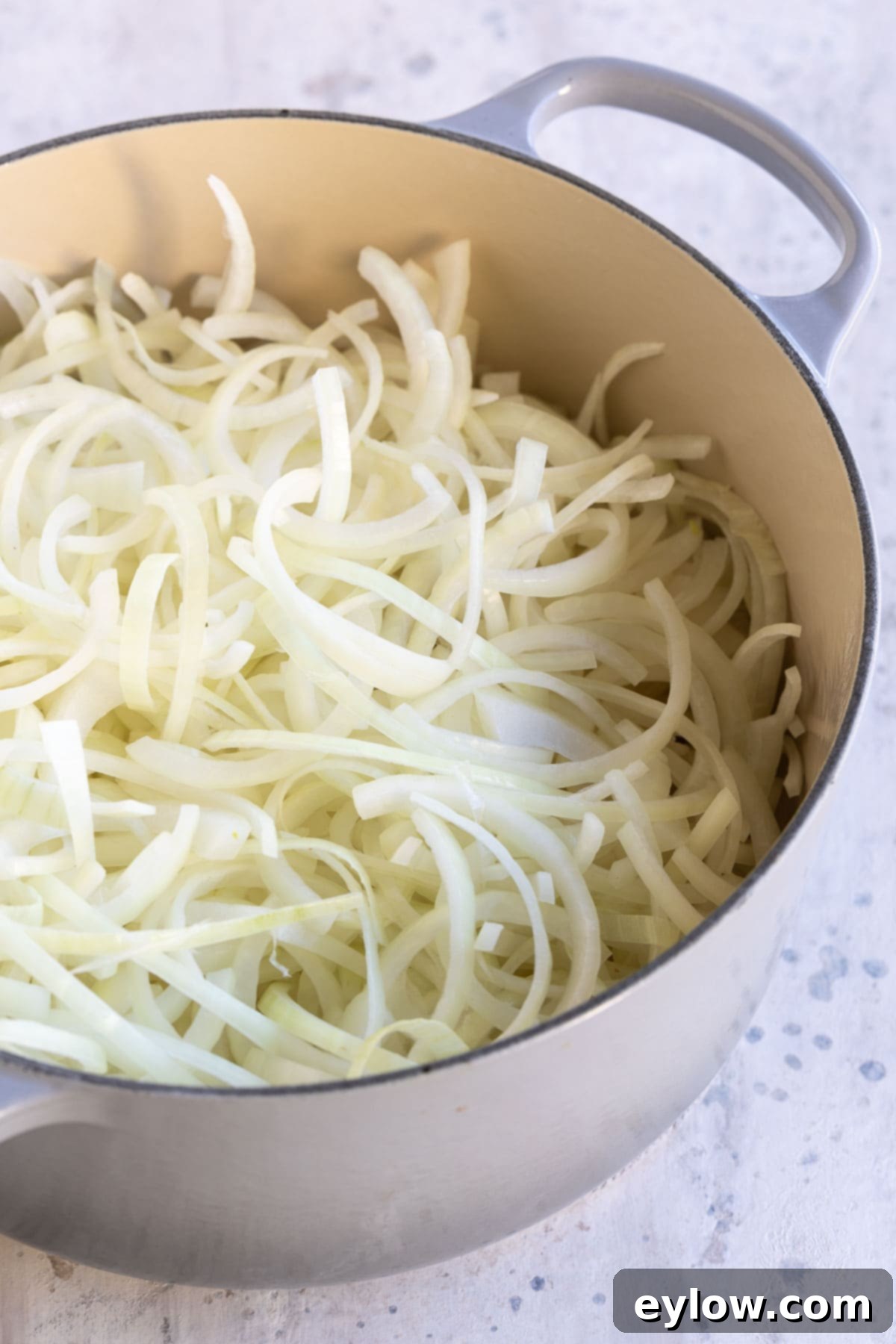
Let’s dive into the heart of French onion soup: the onions! These versatile vegetables are true flavor powerhouses, offering a delightful balance of sweet, savory, and pungent notes. While yellow onions are most traditional, you have several excellent options to choose from, each lending a slightly different character to your finished soup.
- Yellow Onions (aka Brown Onions): These are your standard, go-to onions. With their golden-brown papery skins and robust flavor, they are incredibly versatile. When slowly cooked, their strong initial pungency mellows beautifully, transforming into a deep, sweet, and savory caramelization that is quintessential to French onion soup. They hold up well to long cooking times.
- Spanish Onions: A close relative to yellow onions, Spanish onions tend to be larger and have a slightly milder flavor profile. They still caramelize wonderfully, offering a sweet depth that is perhaps a touch less intense than a standard yellow onion, making them a good choice if you prefer a subtly sweeter soup.
- White Onions: Similar in size and texture to yellow onions, white onions possess a milder, slightly sweeter flavor and a thinner, white papery skin. They caramelize well and can contribute a delicate sweetness, though they may not develop the same robust depth of flavor as yellow or brown onions.
- Sweet Onions: Varieties like Walla Walla, Maui, Oso Sweet, Mayan Sweet, Texas Sweets, and Vidalia fall into this category. Characterized by a higher sugar content and less sulfur, these onions are notably less pungent (and less likely to make you cry!). They caramelize exceptionally well and quickly due to their high sugar content, resulting in an intensely sweet and juicy flavor. Their higher water content means they might cook down a bit more, so you might need slightly more by weight.
Regardless of the type you choose, ensure they are sliced uniformly to promote even caramelization. Aim for about ¼-inch thick half-rounds after cutting them stem to root. This consistency is crucial for achieving that perfect, melt-in-your-mouth texture.
Step-by-Step Guide: How to Make This Easy French Onion Soup
Creating this restaurant-quality French onion soup at home is a rewarding process. Follow these detailed steps to ensure a flavorful and satisfying result.

Prepare the Onions:
Begin by carefully peeling your chosen onions. Then, cut each onion in half from the stem to the root. Place the cut side down on your cutting board and slice crosswise into ¼-inch thick half-rounds. Uniform slicing is crucial here for even caramelization. For a rich and balanced flavor, I prefer using a combination of olive oil and butter to cook the onions, but you can certainly use all butter (regular or plant-based) or all olive oil based on your preference or dietary needs.
The Art of Caramelizing Onions:
This is the most critical step, requiring patience and a watchful eye. Heat your chosen fat (butter and/or olive oil) in a heavy-bottomed pot like a Dutch oven over medium-low heat. Add your sliced onions, along with a pinch of salt to help them release their moisture. The key here is *slow cooking*. Avoid rushing the process by cranking up the heat, as this will lead to burning rather than caramelization, resulting in a bitter flavor. Over approximately 45 minutes, the onions will gradually transform: first becoming translucent, then softening, and slowly turning a pale golden hue before deepening into a rich, dark amber. Stir them occasionally to prevent sticking and ensure even browning. This extended cooking time allows the onions’ natural sugars to caramelize, developing incredible sweetness and a complex umami depth that is foundational to French onion soup. They will become so tender they almost melt in your mouth. Trust the process; this patience is indeed a virtue that yields unparalleled flavor.
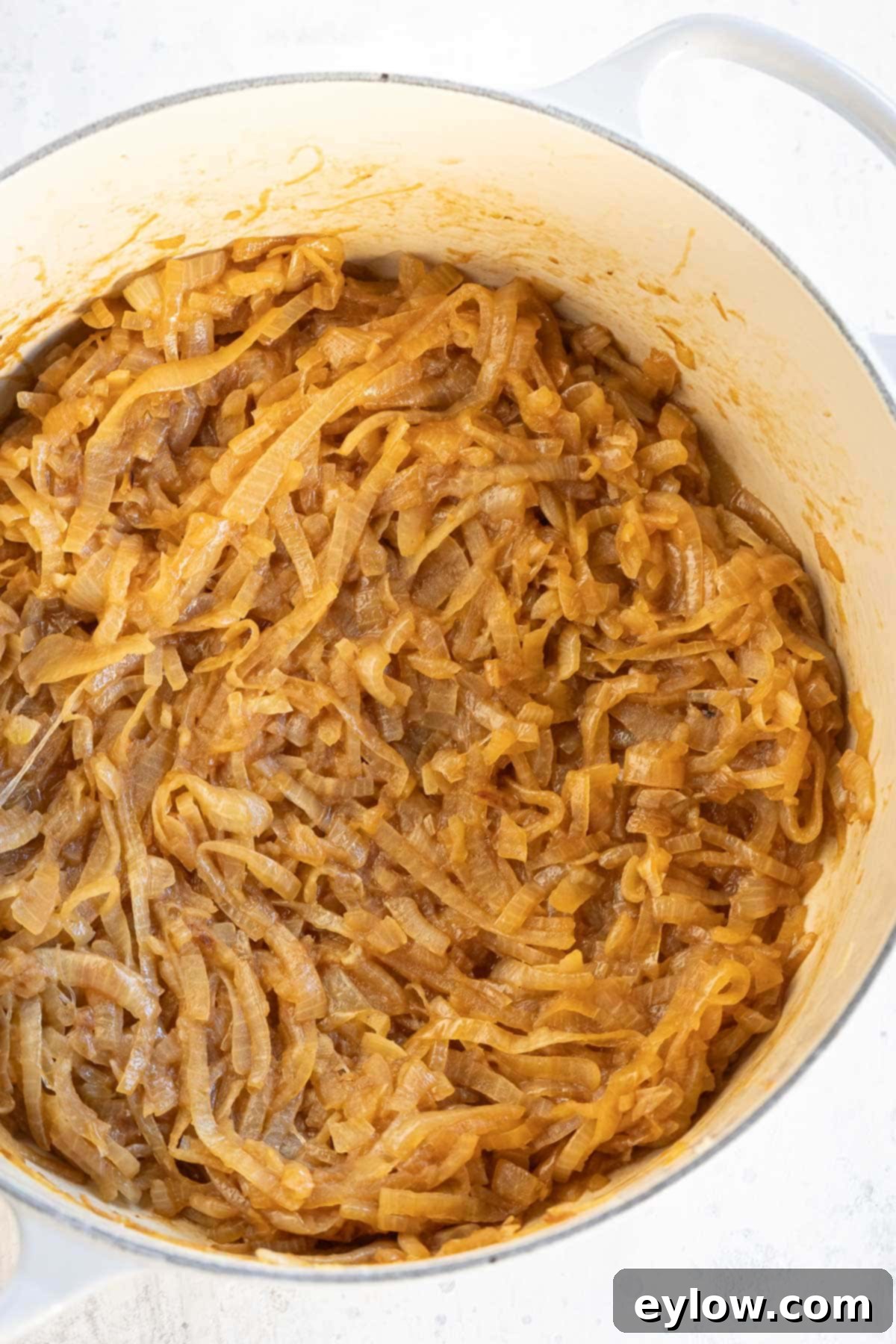
Deglaze and Simmer the Broth:
Once your onions have achieved a beautiful, deep golden-brown caramelization, it’s time to deglaze the pot. Pour in your dry white wine (or sherry, red wine, water, or broth). Use a wooden spoon to scrape up all the flavorful browned bits (known as “fond”) from the bottom of the pot. These bits are packed with concentrated flavor that will enrich your soup. Cook until the wine has reduced by about half, allowing its sharp edges to mellow. Then, add the chosen broth, fresh thyme sprigs (tied together with kitchen twine for easy removal, a great chef’s tip!), and a bay leaf. Bring the soup to a gentle simmer and let it cook for about 15 minutes. This simmering period allows all the flavors to meld and deepen harmoniously. Before serving, remember to remove and discard the thyme sprigs and bay leaf.
Prepare the Cheesy Croutons:
While your onions are luxuriating on the stovetop, you can prepare the irresistible cheesy croutons. These are a crucial component, adding texture, rich flavor, and that iconic cheesy pull.
Broil cheese-topped bread (croutons) until golden and bubbly: Use your favorite bread for this step. A slightly stale French baguette, sliced French bread, or even gluten-free artisan bread works perfectly. For an extra layer of flavor, you can brush the bread with a mixture of melted olive oil, butter, and a touch of granulated garlic before topping with cheese. Arrange the bread slices on a foil-lined baking sheet. Generously top each slice with grated Gruyère and a sprinkle of Parmesan cheese. Place the baking sheet under a preheated broiler set to the second rack from the top (not too close to avoid burning). Broil until the cheese is melted, bubbly, and beautifully golden brown. Keep them warm in a low oven until you’re ready to serve.
Chef’s Note: Traditionally, French onion soup is often served in individual, broiler-safe crocks, with cheese melted directly over the top and extending over the edges of the bowl. While undeniably dramatic, this method can be quite messy to clean up, and sometimes leads to wasted cheese stuck to the bowl. I prefer the “cheesy crouton” route. It’s not only delicious and easier to manage but also ensures no wasted cheese and simplifies cleanup considerably. Plus, you can easily make extra croutons for snacking or to add more to your bowl as desired – a truly delightful bonus!
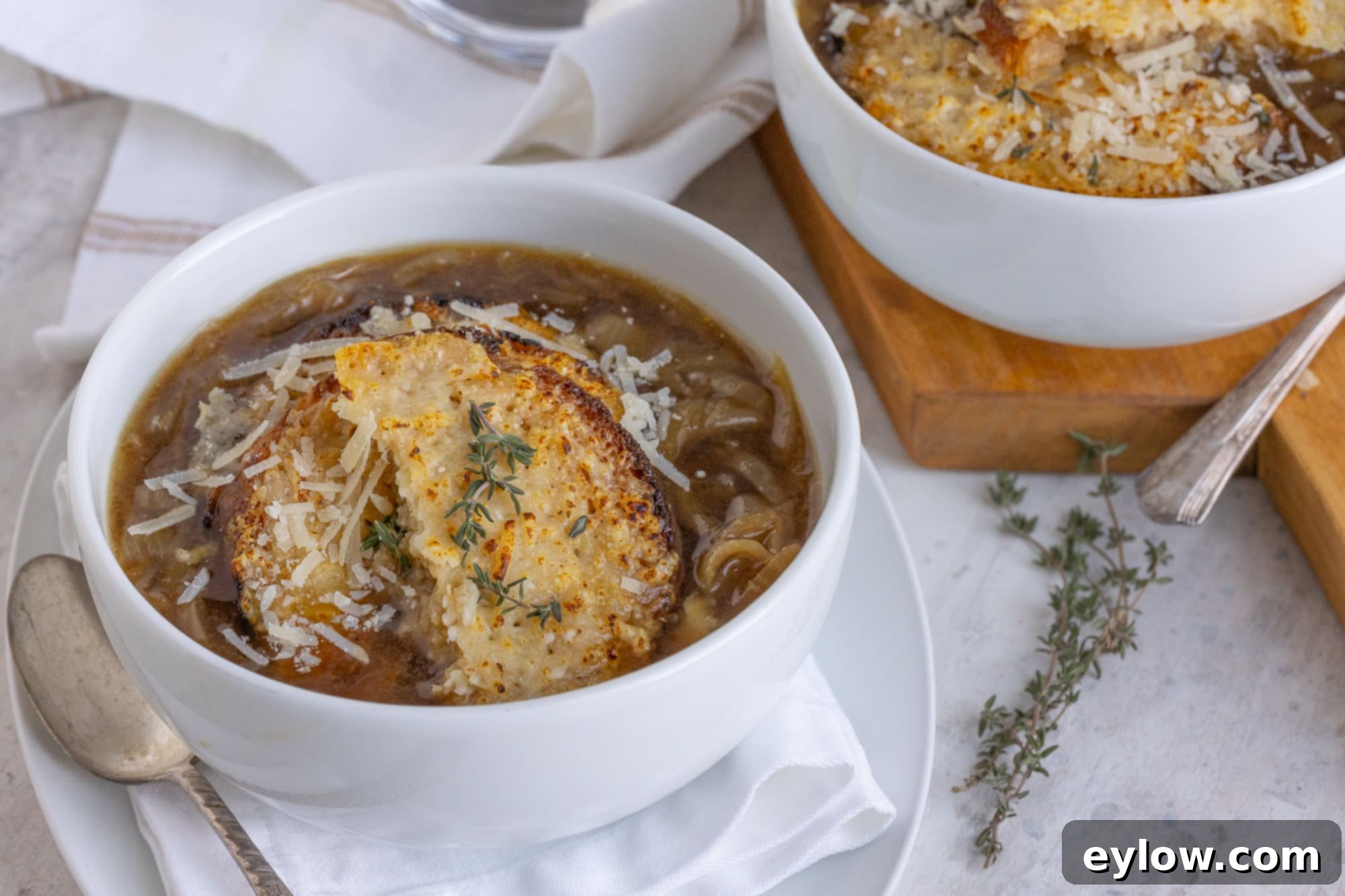
Serving Your Exquisite French Onion Soup
Serve your French onion soup piping hot, directly from the pot, into individual bowls. Crown each serving generously with your freshly made homemade cheesy croutons. For an extra touch of indulgence, a final sprinkle of grated Parmesan cheese and a few fresh parsley leaves (if desired) will elevate the presentation and add a hint of freshness. You might find yourself wanting to make extra cheesy croutons – they are incredibly addictive, especially when soaked in the soup’s rich, savory broth.
French onion soup makes an elegant and satisfying starter course before a more substantial meal. It also shines as the centerpiece of a lighter lunch or dinner when paired with a crisp green salad tossed in a vinaigrette, or alongside an entree salad with a lean protein like grilled chicken. Its hearty nature also makes it a perfect companion to a gourmet sandwich.
Storage & Make-Ahead Tips
One of the beauties of French onion soup is its versatility when it comes to preparation and storage. You can enjoy the rich flavors even days later or save it for a quick, comforting meal.
Can I make French onion soup ahead of time? Absolutely! The soup base (the caramelized onions and broth) can be prepared up to 3 days in advance. Store it in an airtight container in the refrigerator. When you’re ready to serve, gently reheat the soup over low heat on the stovetop, with a lid on to prevent evaporation. While the soup is reheating, prepare your cheesy croutons fresh, ensuring they maintain their crispy, golden texture.
Can I freeze this soup? Yes, French onion soup freezes beautifully! Pour the cooled soup base (without the bread and cheese croutons) into freezer-safe containers or bags, leaving a little headspace for expansion. It can be stored in the freezer for up to 3 months. When ready to enjoy, thaw overnight in the refrigerator or gently reheat from frozen on the stovetop, adding a splash of extra broth if needed. Remember to always make the bread and cheese croutons fresh just before serving for the best texture and flavor. Don’t forget to label and date your frozen soup for easy tracking!
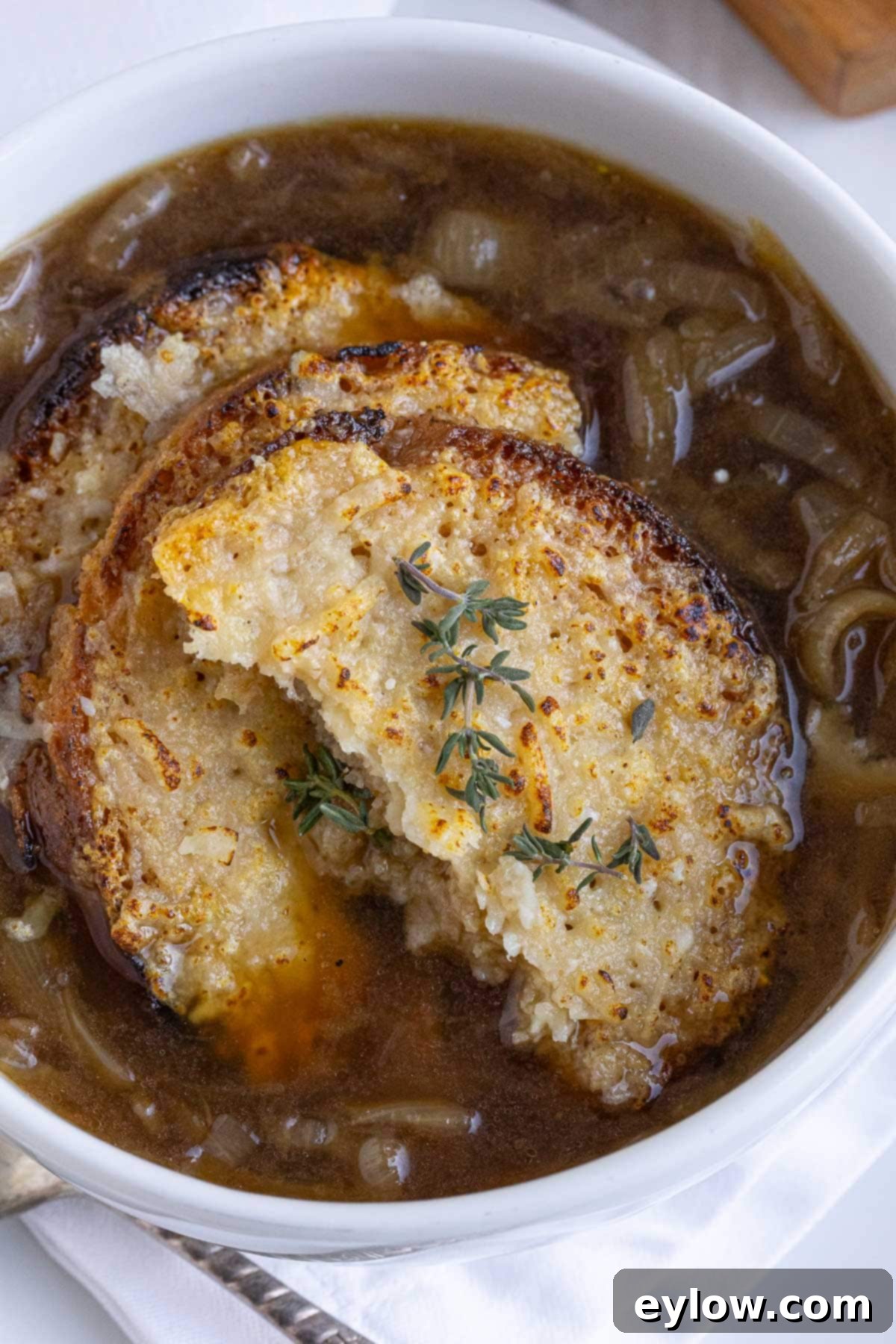
French Onion Soup: Your Questions Answered
French onion soup, or “Soupe à l’oignon gratinée” in French, owes its origin to France, where resourceful cooks took the humble onion – a staple and often considered peasant food – and transformed it into a culinary star. The technique of slow caramelization, coupled with a rich broth and topped with toasted bread and melted cheese, became a beloved classic that has been enjoyed for centuries, cementing its place in French culinary tradition.
If you need to avoid cow’s milk cheese, don’t worry! You can achieve a delicious cheesy topping with alternatives. Try a hard goat milk cheddar cheese, which often melts well and offers a unique, tangy flavor. For a vegan option, look for high-quality plant-based cheeses specifically designed for melting, such as vegan Gruyère or Swiss-style alternatives.
Gruyère is traditional, but many other cheeses can stand in beautifully. Excellent substitutes include Swiss cheese (Emmenthaler is a popular choice), Mozzarella, Fontina, or Gouda. The key is to choose a flavorful cheese that melts well and creates that desirable bubbly, golden crust. A blend of cheeses can also work wonders!
Yes, French onion soup is an excellent make-ahead dish! You can prepare the soup base (caramelized onions and broth) up to 3 days in advance. Store it in an airtight container in the refrigerator. When you’re ready to serve, gently reheat the soup over low heat with a lid until simmering hot. While the soup is heating, prepare the cheesy croutons fresh, as they are best enjoyed right out of the broiler. This strategy makes entertaining much easier!
Patience is paramount here! While some recipes claim quicker times, truly caramelized onions – those that are deeply sweet, savory, and soft – typically take anywhere from 45 minutes to an hour, sometimes even longer, depending on the heat and quantity. Don’t rush this process; maintain a consistent medium-low heat and stir occasionally. The goal is a rich, amber-brown color, not a quick char.
Bitterness in French onion soup is almost always a sign that the onions were cooked too quickly or burned during the caramelization process. High heat can char the sugars in the onions instead of slowly browning them, leading to an acrid taste. Ensure you cook the onions over medium-low heat, stirring frequently, until they are evenly golden brown and sweet, not blackened.
For deglazing, a dry white wine like Sauvignon Blanc, Pinot Grigio, or even a dry sherry works beautifully. These wines add acidity and depth without overpowering the delicate onion flavor. If you prefer red wine, a dry, light-bodied option like Pinot Noir can also be used. Always use a wine you would enjoy drinking, as its flavor will concentrate in the soup.
More Comforting Soup Recipes to Explore
If you’ve enjoyed mastering this French onion soup, you’ll love diving into more heartwarming recipes. Try one of these delicious soups, or check out our full soup category for even more options. We have something for every craving!
- Roasted Red Pepper Soup (Sheet Pan Recipe)
- Easy Instant Pot Chicken Rice Soup Recipe
- Beef Barley Vegetable Soup
- Mexican Chicken Tortilla Soup Recipe
⭐️ Share Your French Onion Soup Experience!
If you’ve made this delicious French Onion Soup, we’d love to hear from you! Please take a moment to add your comment below. Your feedback is invaluable and truly helps other readers. If you absolutely loved it, please consider giving it a 5-star rating – it makes a huge difference! If you encountered any issues or have questions, don’t hesitate to ask; I’m here to help you perfect this classic dish.
📖 Recipe

Easy French Onion Soup Recipe
Sally Cameron
Pin Recipe
Equipment
-
5 ½ quart Dutch oven or heavy pot
Ingredients
French Onion Soup
- 3 pounds onions
- 1 tablespoon unsalted butter or all olive oil
- 1 tablespoon olive oil or all butter
- ½ teaspoon sea salt
- ¼ teaspoon ground black pepper
- ½ cup dry white wine or dry sherry, red wine, water, or broth
- 3 sprigs fresh thyme or ½ teaspoon dried thyme
- 1 bay leaf
- 5 cups low sodium broth beef, chicken, turkey or vegetable
- 1 teaspoon Worcestershire optional
Cheesy Croutons
- 2 tablespoons olive oil
- 2 tablespoons unsalted butter
- ½ teaspoon granulated or powdered garlic
- 4-6 slices artisan bread or baguette regular or gluten-free
- ½ cup grated Gruyere cheese and ounce or two
- 2-3 tablespoons grated Parmesan cheese
Instructions
Slice and cook onions
-
Cut onions in half through the stem end, peel and slice into ¼”thick half rounds.
In a large heavy pot (5 ½ quart Dutch oven), melt the butter and olive oil over medium-low heat. Add the onions and allow them to cook until soft and deeply golden brown (caramelized) about 45 minutes, stirring occasionally. Watch the onions and if browning too quickly turn your heat down. Don’t rush this step.
-
When onions are a rich golden brown, de-glaze the pan with the wine, scraping up and tasty bits on the bottom of the pan.
Cook until wine is reduced by half. Add the salt, thyme and bay leaf. Turn the heat up a bit and add the broth. Simmer on low until flavors are blended and soup is hot, about 15 minutes.
While soup is finishing, make the croutons.
Make cheesy croutons
-
Melt the olive oil, butter, and garlic together in the microwave using low power. When its all melted and smooth, use it to brush on the bread before broiling (optional step).
-
Trim the bread so pieces fit inside the bowl. Turn on the broiler and set the rack to the second level down from the top (not too close). Line a baking sheet with foil. Lightly brush the bread with the melted garlic butter blend. Arrange grated cheese on top of the bread and broil until golden and bubbly. Keep warm until serving time.
Finish the soup and serve
-
When soup and croutons are ready, stir in the Worcestershire sauce and top with the cheesy croutons. Sprinkle with fresh parsley leaves as garnish if desired.
Notes
For other cheese options to the Gruyere, try Swiss cheese, Mozzarella, Emmenthaler, Fontina, or Gouda or a flavorful cheese that melts well.
If serving the soup at a later time, wait until just before serving to make the cheesy croutons.
Nutrition
